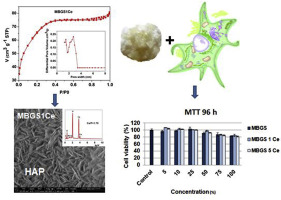Microporous and Mesoporous Materials ( IF 5.2 ) Pub Date : 2018-09-28 , DOI: 10.1016/j.micromeso.2018.09.029 I. Atkinson , E.M. Anghel , S. Petrescu , A.M. Seciu , L.M. Stefan , O.C. Mocioiu , L. Predoana , M. Voicescu , S. Somacescu , D. Culita , M. Zaharescu

|
Bone defects due to trauma or diseases causing bone loss have led to an increased demand for new materials that have applications in therapies for bone pathologies. Mesoporous bioactive glasses (MBGs), based on 70SiO2-(26-x)CaO4P2O5-xCeO2 (x = 0, 1 and 5 mol % for MBGS, MBGS1Ce and MBGS5Ce) were synthesized by evaporation-induced self-assembly (EISA) method. Ceria was selected due to its antimicrobial and antioxidant properties and positive impact on cells differentiation and mineralization. The pore size values of 2.8 nm confirmed the mesoporosity of the obtained bio-glasses. The biocompatibility tests on mouse fibroblast cells (NCTC clone L929) using 3-(4,5-dimethylthiazol-2-yl)-2,5-diphenyltetrazolium bromide (MTT) and lactate dehydrogenase (LDH) activity assays revealed no cytotoxicity of Cerium containing MBGs. Formation of a hydroxycarbonate apatite (HCA) layer on MBGs surface, e.g. bioactivity of BMGs, was confirmed by XRD, FTIR, SEM and Raman Spectroscopy while presence of Ce3+/Ce4+ in the glasses before body simulated fluid (SBF) immersion was determined by XPS, UV–Vis measurements. The obtained results show that investigated MBGs are potential materials for applications in bone regeneration.
中文翻译:

含铈的介孔生物活性玻璃:材料表征,体外生物活性,生物相容性和细胞毒性评估
由于外伤或引起骨质流失的疾病引起的骨缺损导致对在骨病理学治疗中应用的新材料的需求增加。基于70SiO 2-(26-x)CaO 4P 2 O 5 -xCeO 2的中孔生物活性玻璃(MBG)通过蒸发诱导自组装(EISA)方法合成(对于MBGS,MBGS1Ce和MBGS5Ce,x = 0、1和5mol%)。选择Ceria是因为其具有抗微生物和抗氧化特性,并且对细胞分化和矿化具有积极影响。2.8nm的孔径值证实了所获得的生物玻璃的介孔性。使用3-(4,5-二甲基噻唑-2-基)-2,5-二苯基四唑溴化物(MTT)和乳酸脱氢酶(LDH)活性测定法对小鼠成纤维细胞(NCTC克隆L929)的生物相容性测试表明,不含铈的细胞毒性MBG。在存在Ce 3 + / Ce 4+的情况下,通过XRD,FTIR,SEM和拉曼光谱法证实了MBG表面上羟基碳酸盐磷灰石(HCA)层的形成,例如BMG的生物活性。通过XPS,UV-Vis测量确定人体模拟液(SBF)浸入之前在眼镜中的浓度。获得的结果表明,所研究的MBG是用于骨再生的潜在材料。



























 京公网安备 11010802027423号
京公网安备 11010802027423号